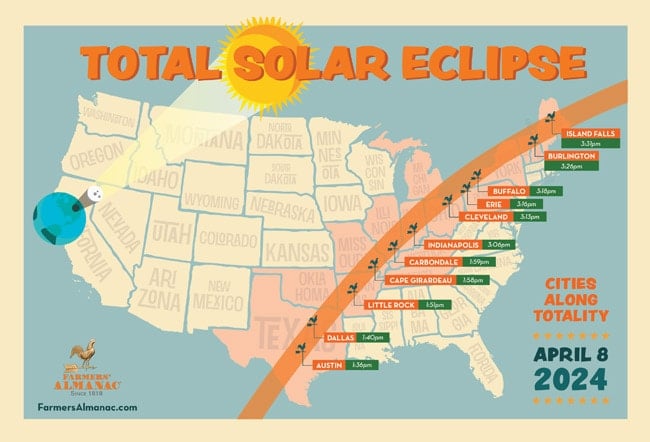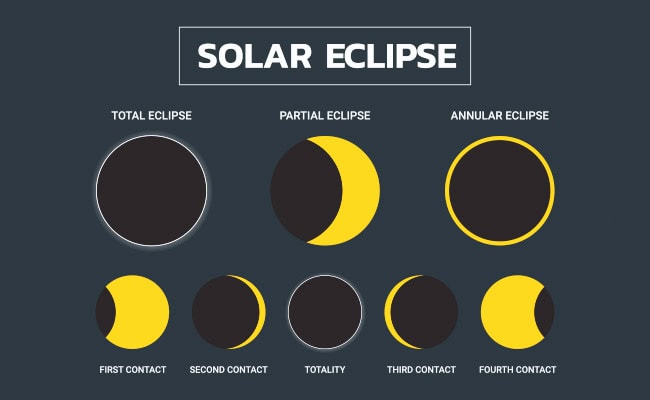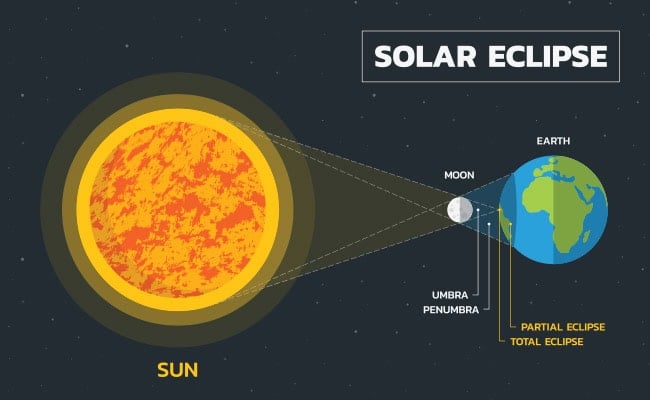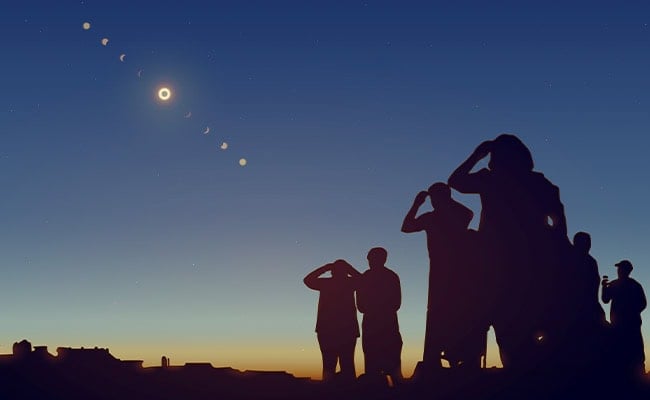2024 and 2025 will each have four eclipses: two solar eclipses and two lunar eclipses. The key dates are April 8, 2024 and March 13-14, 2025 when a total solar eclipse and a total lunar eclipse (also known as a “Blood Moon”) occur, respectively. Here are details about each of the upcoming eclipses, including when and where to get the best views. Plus, ancient folklore like why it’s believed to be good luck to bang a drum during a solar eclipse and other odd superstitions!
Eclipses 2024 Calendar
There will be four eclipses in 2024, including one total solar eclipse. Here are the details of each:
1) March 25, 2024 Eclipse (Penumbral Lunar Eclipse)
On March 25, 2024, there will be a penumbral lunar eclipse. This type of eclipse occurs when the Moon passes through the outer part of Earth’s shadow, called the penumbra, during an imperfect alignment of the Sun, Earth, and Moon. Penumbral eclipses can be challenging to observe because the Moon often appears only slightly dimmer, resembling its normal appearance but with a slight darkening.
This eclipse will be more visible in the Western Hemisphere. The darkest part of the shadow, known as the umbra, will be located south of the Moon’s path. During the middle of the eclipse, for about half an hour, those who know what to look for may notice a faint gray spot near the Moon’s lower edge.
TIMES FOR THIS ECLIPSE:
| Moon enters penumbra: 12:53 a.m. EDT |
| Mid-eclipse: 3:12 a.m. EDT |
| Moon leaves penumbra: 5:32 a.m. EDT |
| Magnitude of the eclipse: 0.956 |
2) April 8, 2024 Eclipse (Total Solar Eclipse)
On April 8, 2024, there will be a total solar eclipse a/k/a the Great Solar Eclipse. During this event, the shadow cone of the Moon, known as the umbra, will touch the Earth’s surface. Don’t miss this rare event! The next time a total eclipse will be in 2033 and you’ll have to travel to Alaska!
Related product: Farmers’ Almanac Solar Eclipse Glasses
The path of totality will be approximately 125 miles wide, represented by the width of the orange arc on our eclipse map:

The umbra will move into southern Texas at 1:27 p.m. Central Time. Many Farmers’ Almanac readers live in Texas or plan to travel there to watch this rare event, so here’s a helping hand …
Where will you be? Please share in the comments!
12 National Parks in Texas
Still making plans? Here are 12 National Parks in Texas that Farmers’ Almanac recommends, including links to make reservations. (These parks are listed in order of their total eclipse times beginning in the southwest and moving northeast.)
- Garner
- Lost Maples
- Hill Country
- Old Tunnel
- Lyndon B. Johnson
- Enchanted Rock
- Inks Lake and Longhorn Cavern
- Mother Neff
- Lake Whitney
- Purtis Creek
- Lake Tawakoni
- Cooper Lake
Curious about other locations in Texas? See a more complete list, provided by Texas Parks & Wildlife Department.
Related:
After Texas, the umbra will continue its journey through the Deep South to the greater Ohio Valley. Then it will travel into the southeast Great Lakes, upstate and western New York, a small portion of Ontario and Quebec, and New England. Later, the shadow will go across the Canadian Maritime Provinces (New Brunswick, Prince Edward Island, Nova Scotia, Newfoundland) before exiting over the North Atlantic Ocean at sunset.
Across central and eastern Canada and the United States, up to 80 percent or more of the Sun’s diameter will be obscured by the passing new Moon.
While most of North America, excluding much of Alaska, will witness a partial eclipse, areas such as Ireland, parts of the United Kingdom, Spain, and Portugal will have a very brief glimpse near sunset.
3) September 17-18, 2024 Eclipse (Partial Lunar Eclipse)
On September 17-18, 2024, there will be a partial lunar eclipse. During this event, the Moon will pass near the center of the Earth’s shadow, but not directly through it. Instead, it will graze the edge of the Earth’s dark umbra. The umbra is the darkest part of the shadow and has a distinct, sharp rim. However, during this eclipse, only about one-twelfth of the Moon’s diameter will be within the umbra (at most). Unlike the faint gray penumbra (see 3/25/24 event above), the umbra is much darker.
The eclipse will be visible across much of North America (excluding Alaska and Hawaii) and all of South America. Additionally, all of Europe and most of Africa will have the opportunity to see the eclipse before moonset or in the early morning hours of the 18th. In contrast, for those living near the Pacific coasts of Washington, Oregon, and northern California, the Moon will rise in a partial eclipse on the evening of the September 17, 2024.
TIMES FOR THIS ECLIPSE:
| Moon enters penumbra: 8:41 p.m. EDT |
| Moon enters umbra: 10:12 p.m. EDT |
| Mid-eclipse: 10:44 p.m. EDT |
| Moon leaves umbra: 11:52 p.m. EDT |
| Moon leaves penumbra: 12:47 p.m. (Sept. 18) EDT |
| Magnitude of the eclipse: 0.085 |
4) October 2, 2024 Eclipse (Annular “Ring Of Fire” Solar Eclipse)
This solar eclipse is known as an annular eclipse, where the Moon is slightly too far from the Earth to completely cover the Sun, creating a dazzling ring of sunlight around the Moon’s silhouette.

The eclipse’s path will first sweep eastward, then southeastward, across the southern Pacific Ocean. Initially, it will pass north of Kiribati, then northeast of French Polynesia and Pitcairn Island. At the point of greatest eclipse, the annular phase will last for an impressive 7 minutes and 24 seconds, with the Sun at an altitude of 69°. The width of the eclipse path will span 165 miles. The eclipse’s path also crosses Easter Island where at 1:04 p.m. local time, the captivating solar ring will persist for 6 minutes and 5 seconds.
About 68 minutes later, the Moon’s antumbral shadow, which extends beyond the umbra, touches down in South America. It enters from the Pacific over Parque Nacional Laguna San Rafael in Chile and exits over the Atlantic at Cañadón Once de Septiembre in Argentina. The path skirts just north of the Falkland Islands and eventually lifts off the Earth’s surface north of the southern Georgia and Sandwich Islands.
During the mid-morning hours, a partial eclipse will be visible over Baja California Sur, followed by a partial eclipse over the southern two-thirds of South America during the afternoon hours.
TIMES FOR THIS ECLIPSE:
| Partial eclipse begins: 11:42 a.m. EDT |
| Annular eclipse begins: 12:53 p.m. EDT |
| Greatest eclipse: 2:42 p.m. EDT |
| Annular eclipse ends: 4:36 p.m. EDT |
| Partial eclipse ends: 5:46 p.m. EDT |
| Maximum duration of annularity: 7 minutes 25.1 seconds |
Eclipses 2025 Calendar
1) March 13-14, 2025 Eclipse (Total Lunar Eclipse)
This total lunar eclipse promises a captivating spectacle for both North and South America. For the eastern half of North America, it’s an after-midnight event on March 14, 2025, while viewers farther west will experience it in the late evening.
Positioned near the border of Leo and Virgo, the Moon will be situated roughly between the prominent stars Regulus and Spica. Notably, totality will last longer than usual, spanning 1 hour and 7 minutes.
TIMES FOR THIS ECLIPSE:
| Moon enters penumbra: 11:57 p.m. EDT (March 13) |
| Moon enters umbra: 1:09 a.m. EDT (March 14) |
| Total eclipse begins: 2:25 a.m. EDT |
| Mid-eclipse: 2:58 a.m. EDT |
| Total eclipse ends: 3:32 a.m. EDT |
| Moon leaves umbra: 4:48 a.m. EDT |
| Moon leaves penumbra: 6:00 a.m. EDT |
| Magnitude of the eclipse: 1.180 |
As the Moon traverses north of the center of the Earth’s shadow, its upper part will appear brighter during the total phase, while the lower portion will exhibit a darker, more subdued hue. Typically, during totality, atmospheric effects lend the Moon a reddish or coppery glow. However, the specific brightness and colors visible on the Moon will be influenced by the state of our atmosphere, influenced by factors such as clouds, volcanic dust, and other pollutants.
2) March 29, 2025 Eclipse (Partial Solar Eclipse)
The dark shadow cone of the Moon, essential for witnessing a total eclipse, will completely bypass the Earth, skimming approximately 180 miles above the North Pole. However, the Moon’s outer shadow, known as the penumbra, will touch a portion of the Northern Hemisphere, creating a partial eclipse visible across varying degrees from northwest Africa, much of Europe, and northwest Russia.
Additionally, Iceland, Greenland, and parts of eastern North America, east of a line from Oakville, ON to Virginia Beach, VA, will witness the eclipse’s final stages just after sunrise.
South America will also experience a faint effect as the penumbra brushes parts of Suriname, French Guiana, and Amada in Brazil. The peak of the eclipse occurs in Nunavik, the northernmost region of Quebec, Canada. Remember, it’s crucial to take precautions and avoid looking directly at the Sun without proper eye protection.
TIMES FOR THIS ECLIPSE:
| Partial eclipse begins: 4:50 a.m. EDT |
| Greatest eclipse: 6:47 a.m. EDT |
| Partial eclipse ends: 8:43 a.m. EDT |
| Magnitude of the eclipse: 0.938 |
3) September 7, 2025 Eclipse (Total Lunar Eclipse)
Once again, the Moon will cross directly over the Earth’s shadow, although this time it will pass to the south of the center of the shadow. And on this occasion, all the places in the Eastern Hemisphere that were shut out from a view of the previous eclipse are now in perfect position for this event: from central Africa and eastern Europe, east to eastern Asia, Japan, Indonesia, and Australia.
Unfortunately, North and South America will not see this total lunar eclipse because the Moon will be below the horizon, and it will be daytime when this eclipse is taking place. Totality will last longer than average. In fact, in terms of duration, it lands among the top 25% of all eclipses, at 83 minutes.
TIMES FOR THIS ECLIPSE:
| Moon enters penumbra: 11:28 a.m. EDT |
| Moon enters umbra: 12:26 p.m. EDT |
| Total eclipse begins: 1:30 p.m. EDT |
| Mid-eclipse: 2:11 p.m. EDT |
| Total eclipse ends: 2:53 p.m. EDT |
| Moon leaves umbra: 3:56 p.m. EDT |
| Moon leaves penumbra: 4:55 p.m. EDT |
| Magnitude of the eclipse: 1.363 |
4) September 21, 2025 Eclipse (Partial Solar Eclipse)
As was the case in March, the dark shadow cone of the Moon will again completely miss the Earth, this time passing about 260 miles (410 km) below the South Pole. But the Moon’s outer shadow, or penumbra, does interact with a large swath of the South Pacific and Southern Oceans.
New Zealand will be treated to a fairly significant solar obscuration shortly after local sunrise: 61% for Auckland; 73% in Oban. Even a larger amount of the Sun will be covered for parts of Antarctica, but likely the only ones who will see it will be the penguins.
TIMES FOR THIS ECLIPSE:
| Partial eclipse begins: 1:29 p.m. EDT |
| Greatest eclipse: 3:41 p.m. EDT |
| Partial eclipse ends: 5:53 p.m. EDT |
| Magnitude of the eclipse: 0.855 |
Eclipse FAQ
What is an eclipse exactly?
When many people hear the term “eclipse,” they think of a solar eclipse. Solar eclipses occur when the Moon’s motion in the sky blocks the Sun’s light. But the Sun isn’t the only celestial object that may be eclipsed! Stars and planets can be eclipsed by the Moon as well, which is called an “occultation.” The Moon can also be eclipsed by the Earth, which is known as a lunar eclipse.
What happens during a lunar eclipse vs solar eclipse?
A solar eclipse occurs when the Moon is directly between Earth and the Sun, and the Moon casts a shadow over Earth, shown in this illustration:

On the other hand, during a lunar eclipse the Earth and Moon trade places and therefore the Earth casts a shadow upon the Moon. Solar and lunar eclipses have specific names according to how much shadow coverage is involved.
Solar eclipses always happen during a new Moon phase, but lunar eclipses always occur during the full Moon phase. Whether there is an eclipse or not is based on the alignment of the three celestial bodies: Sun, Moon, and Earth.
Related:
How often to eclipses occur?
Eclipses typically happen four times each year: two solar eclipses and two lunar eclipses. Though there are sometimes five, six or seven eclipses in a single year. (The last time we saw a year with seven eclipses was 1982 and the next time will be in 2038.)
“Eclipse season” is a time when eclipses are more likely to happen, approximately every six months. During an eclipse season, the Sun, Moon, and Earth line up in a way that makes it possible for eclipses to occur. In this window of time—approximately 34 days—eclipses happen in pairs, two weeks apart. For example, a lunar eclipse will occur on September 7, 2025 followed by a solar eclipse on September 21, 2005.
Can there be three eclipses in one month?
Yes, it is possible to have three eclipses in one month, but it is very rare. The last time there were three eclipses in a single calendar month was in 2000, but it won’t happen again until 2206!
Do eclipses happen earlier and earlier as time goes on?
The time between eclipse seasons is about a week short of six months, so eclipse seasons migrate backward through our calendar, occurring slightly earlier each year.
How many types of solar eclipses are there?
There are four types of solar eclipses: three main types and one that is a combination:
- Total Solar Eclipse: This occurs when the Moon completely covers the Sun, blocking out its light. During a total solar eclipse, the sky becomes dark as if it were nighttime, and the Sun’s corona, or outer atmosphere, becomes visible as a glowing ring around the darkened Moon.
- Annular Solar Eclipse: An annular solar eclipse happens when the Moon is farther away from the Earth, so it appears smaller in the sky. As a result, it doesn’t completely cover the Sun, leaving a ring of sunlight visible around the edges of the Moon. This creates what’s often referred to as a “ring of fire” effect.
- Partial Solar Eclipse: In a partial solar eclipse, the Moon only covers part of the Sun’s disk. This creates a crescent shape in the sky, with a portion of the Sun still visible. The degree of coverage varies depending on the observer’s location.
- Hybrid Solar Eclipse: Also known as an annular-total eclipse, this rare type of eclipse transitions between a total and annular eclipse along its path. It begins as an annular eclipse and then transforms into a total eclipse or vice versa, depending on your location along the eclipse path.
Note: Hybrid solar eclipses are particularly rare celestial events, occurring when the alignment of the Earth, Moon, and Sun is so precise that the eclipse transitions between total and annular phases along its path. This phenomenon adds an extra layer of intrigue for astronomers and skywatchers alike, making hybrid eclipses highly anticipated and sought-after events.
How many types of lunar eclipses are there?
There are three types of lunar eclipses:
- Total Lunar Eclipse: This happens when the Earth passes between the Sun and the Moon, casting its shadow on the Moon. During a total lunar eclipse, the Earth’s shadow completely covers the Moon, turning it a deep red or copper color. This occurs because some sunlight refracts through the Earth’s atmosphere and illuminates the Moon. It is as if all of the sunsets of Earth are being cast upon the face of the Moon. The term “Blood Moon” is often used colloquially to refer to this striking phenomenon.
- Partial Lunar Eclipse: In a partial lunar eclipse, only a portion of the Moon passes through the Earth’s shadow. This results in a section of the Moon appearing darker than usual, but it doesn’t fully disappear as in a total lunar eclipse.
- Penumbral Lunar Eclipse: This type of lunar eclipse occurs when the Moon passes through the faint outer part of the Earth’s shadow, known as the penumbra. During a penumbral lunar eclipse, the Moon may appear slightly dimmer than usual, but the change is subtle and may not be noticeable to the casual observer.
Would you like to learn more about this? Please tell us in the comments!
Would you like to keep learning? We recommend watching this informative video:
When Is The Next Total Solar Eclipse In North America?
- April 8, 2024: this path will stretch from central Texas to northern New England. The duration of totality will average just under 4 minutes (4 minutes 27 seconds in Texas). Interestingly, the path of totality will again encompass Carbondale, Illinois, who played host to this year’s spectacle – their second total eclipse in less than 7 years!
- March 30, 2033: We should also note that a swath of our vast 49th state of Alaska will be darkened by the Moon’s shadow on this date. The northern and western part of the “Great Land State” will be inside the totality path. Nome will see 2 minutes 30 seconds of total eclipse. Alaska also played host to the total eclipses of 1963 and 1972, both occurring in the month of July.
- August 23, 2044: this solar eclipse will envelop much of northeastern Montana and a slice of westernmost North Dakota near local sunset. Totality will last only around 100 seconds, but the width of the shadow path is immense: in excess of 300 miles.
- August 12, 2045: A truly great eclipse will visit the United States, stretching east-southeast along a broad arc from northern California, through Kansas/Oklahoma and then down into Florida. Totality will last unusually long, ranging from 4 minutes 22 seconds along the Pacific coast to 6 minutes 06 seconds at Port St. Lucie, Florida.
- March 30, 2052: will see the Moon’s shadow clip the southern tip of southern Texas (Brownsville will see 1 minute 48 seconds of totality). The shadow then continues northeast across the Gulf of Mexico, grazing the Louisiana Parishes that border Barataria Bay, the Mississippi Delta and Breton Sound, before streaking across the Florida Panhandle, clipping the southeast corner of Alabama, rolling through the lower third of Georgia before heading out to sea at the South Carolina coast. And yes, as was the case in 2017, Charleston, South Carolina will be in the totality path!
- May 1, 2079: Nine minutes after sunrise, the Moon will totally eclipse the Sun for just over 2 minutes as seen from the Tri-State Area; New York’s first total solar eclipse since 1925.
Solar Eclipse Myths And Superstitions
In our technological age, relatively rare occurrences like total solar eclipses are well understood by scientists. But in the days when life was harder and accurate information scarcer, eclipses were often seen as a mysterious and unwelcome disruption of the natural order.
Many cultures viewed a solar eclipse as if some mythic creature devouring the Sun. In ancient China, it was a celestial dragon, and in southeast Asia, they imagined it to be a giant turtle, frog, or toad. In Korea, “fire dogs” were believed to steal the Sun and when they bit it, an eclipse resulted.
For the Vikings, a hungry wolf named Sköll (whose name means “Treachery”) raced across the sky, hunting down and eating the Sun. Even cultures like Greece and Rome—which had the mathematical and observational knowledge to be able to predict eclipses—viewed eclipses as bad omens, portents of evil, and fearsome astronomical events.
In Hindu mythology, it was believed that the demon Rahu stole an elixir of immortality, called amrita, but was beheaded by the god Vishnu before he could fully swallow it. Consequently, the demon’s severed head, forever alive, floats around and occasionally devours the Sun. To this day, in India, people make noise by banging pots and pans and setting off fireworks during a solar eclipse to scare Rahu away and make him cough up the Sun.
A northwestern Native American tribe has a legend that a solar eclipse is the result of a quarrel between a great bear and the Sun, ending with the bear taking a huge bite out of it. In fact, the tribe’s name for a solar eclipse translates to Sun got bit by a bear.
Emperors, Kings, and rulers throughout history have been particularly nervous about eclipses. Their court astrologers interpreted them as bad omens that the monarch’s power was in danger. In ancient Babylon, there was the practice of hiring “stand-in” kings to sit on the throne during an eclipse, so any harm would come to them rather than the real king.
In 1133 King Henry I died shortly after a solar eclipse, and some in his court had, in fact, assumed that it was tied to the astronomical event.
Can solar eclipses be good omens too?
Not all of the tales associated with eclipses are negative!
- Herodotus, an ancient Greek scholar, and a battle in the 6th Century B.C. between the Medes and the Lydians, which was raging until a solar eclipse began. It is said the soldiers threw down their arms and stopped fighting, believing that the gods disapproved of the war.
- And in Italy, it is believed that if you plant flowers during a total solar eclipse, they will bloom with more vibrant colors than those planted at any other time.
Related:
Lunar Eclipse Superstitions
Here’s a look at some of the stories, beliefs, myths, and superstitions about lunar eclipses from around the world:
Changes Are Coming: American Indian tribes say lunar eclipses are a sign of transformation (based on the belief that the Moon controls and regulates the Earth)..
Time To Forgive: According to South African mythology, the Sun and Moon fight during an eclipse. It was thought that the people must come together to encourage the celestial bodies to resolve their feud.
Pay It Forward: Tibetan Buddhists believe the effect of good deeds (and bad) are multiplied tenfold during a lunar eclipse.
Relax, Moms: In several cultures, expectant mothers are advised to stay indoors when the Moon turns dark for fear it may curse their unborn child. They should also avoid doing housework, since using a knife or other sharp object during these times is believed to cause birthmarks.
Make Some Noise: Incan civilizations believed that lunar eclipses occurred when a mythological jaguar attacked and ate the Moon. To drive it away, people would shake spears at the night sky and make their dogs bark.
Today, many eclipse watchers give a nod to this ritual with noisemakers in hand to “scare off” whatever is swallowing the Moon.
Whether you believe lunar eclipses are spooky or spectacular, you can’t deny they’re fascinating sights to see!
What are some modern-day beliefs?
To this day, superstitions persist about eclipses. Many cultures still believe that eclipses are evil omens that bring death and destruction. One of the most pervasive is that eclipses are dangerous to young children and pregnant women. Many people, even in our modern times, won’t venture outside during a solar eclipse because of the belief that they will be harmed (be sure to wear protective eclipse viewing eyewear)!
Fortunately, most of us know that solar eclipses are nothing to fear, and we will enjoy them for what they are—a rare and beautiful celestial event!
Join The Discussion
Do you believe that eclipses bring good or bad luck?
Where will you be for the next eclipse?
Share thoughts with your community in the comments below!

